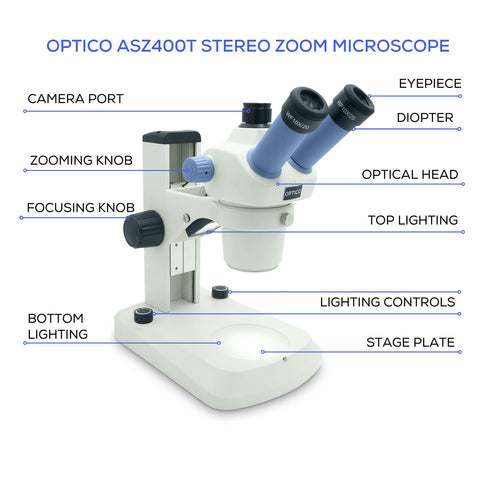
Buying advice for school microscopes
Microscopes are an essential part of any good science education. The exciting new perspectives can inspire a lifelong interest in nature and learning.
But buying the right microscopes for your school can be daunting. Faced with so many models and options, how do you know what features are really necessary? And how will you balance your needs with your budget?
This guide will help you find the right microscopes for your school without breaking the bank.
Stereo or compound?
The first thing to consider is what your students will be looking at.
This is important because there are two different kinds of educational microscope – stereo and compound – used for different purposes.
Stereo
Stereo microscopes are designed to look at larger specimens or samples, such as rocks, insects, minerals or electronics.
As a result, stereo microscopes are often a good choice for younger students as the curriculum at those ages is focused on bigger samples. They will also have the joys of a tactile experience – seeing and doing things by themselves.
Lastly, the controls are simpler to use than the controls and adjustments on compound microscopes.

But don’t rule out stereo microscopes for high school students. They make light work of subjects such as geology, biology and any class involving electronics.
Compound
Compound microscopes are generally more appropriate for older students. They’re designed to observe microscopic samples such as cells, blood samples and micro-organisms, which can’t be viewed using any other method.

Digital microscopes
Digital microscopes have strong appeal for students who have been shaped by technology almost from birth.
A ‘digital microscope’ is any microscope that can transmit the image to a screen, so that you don’t have to look down an eyepiece.

Optico DM130B Digital Biological Microscope
While you can get fully integrated digital microscopes without any eyepieces such as the Dino-Lite Digital Handheld Microscopes, you can also purchase a Digital Camera Eyepiece these simply attach to an existing traditional microscope and send the image to a nearby screen, tablet or smartboard – which makes them hot during a pandemic. It’s much easier to socially distance when don’t have to share an eyepiece.

Dino-Eye Digital Camera Eyepiece
With a little setup, you can even send the microscope images over Wi-Fi or the internet, so any students in quarantine won’t have to miss out on the lesson. It’s also very easy to take and share pictures or video, which can be a great help for assignments and group work.
For schools on a budget, a digital microscope is a great alternative to the more expensive traditional microscope setup. A teacher with a single digital microscope can project their images to the whole class to provide an engaging microscope experience at a fraction of the cost. This lesson format can easily be adapted to remote learning through conferencing software.

Dino-Lite Basic Digital Microscope
Durability
It’s important to consider your teaching environment before buying any microscopes.
Will your microscope be occasionally handled by a few well-supervised students or by dozens of students on a daily basis?
If your microscope will see a lot of use, the risk is it will be handling roughly (with even the occasional drop). Repairs can be expensive and may not be good value given the purchase price. If you want your microscope to last, make sure its construction is sturdy and resistant to damage – that is, opt for a metal frame rather than plastic.
Some models have an option to permanently fix detachable parts to the main body, preventing them being misplaced or damaged in transit. Focus locks are another useful feature – they stop the microscope lens from accidentally colliding with the slide or sample
If your school is located in a particularly humid area, look into the special coatings that stop mould or fungus growing on your microscope.
What features do you need?
Three main considerations are the lenses, magnification and eyepieces.
Objective lenses
Compound microscopes used for high school education should have 4x, 10x and 40x objective lenses (as a minimum). Combined with the standard 10x eyepiece lens, this will provide students with the 40x-400x magnification required for any school syllabus. 100x oil immersion lenses are sometimes used but are often not essential.
Magnifications
Some cheaper microscopes will claim to offer magnifications up to 2500x – this is essentially a marketing scam. You will never need magnifications over 1000x (100x objective multiplied by the 10x eyepiece lens).
There are physical limits that prevent a standard microscope from letting you see any more detail at magnifications beyond 1000x. Higher magnifications provide what is known as ‘empty’ or ‘false’ magnification; technically the magnification is higher, but you’ll see no additional detail and instead get a blurry and distorted image that’s of no use to anyone.
Eyepieces – monocular or binocular?
While binocular eyepieces are standard for adults, younger students can struggle with them. Because children’s eyes are often closer together than adults, peering through both eyepieces can be an unwelcome challenge.
If your microscopes will be used by a broad age group, a monocular eyepiece is a better choice (and they’re cheaper, too).
Price
In hard times, it can be tempting to go for the cheapest model. But it’s important to avoid bottom of the barrel models because they have shoddy build quality and awful optics – there’s no quicker way to discourage your students than with terrible image quality.
You might save a few dollars, but it will be at the expense of your students’ education.
Look instead at the range of microscopes known as ‘student microscopes’. Sourced from reputable suppliers, they have decent quality and are still very affordable. They simply lack some of the more advanced features you may not need anyway.